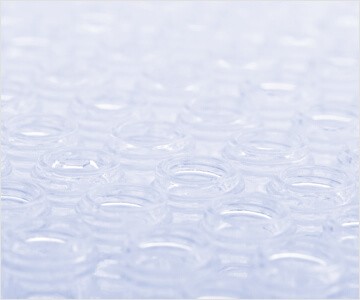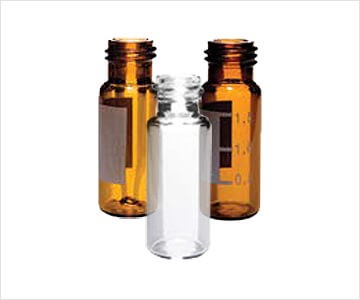How to Choose the Right Chromatography Vial
Chromatography vials are typically used as temporary sample containers for subsequent gas chromatography (GC) or liquid chromatography (LC) analysis. Consider these factors when choosing the correct vial for your applications.
What Are Standard Chromatography Vial Sizes?
Standard chromatography vial sizes include 8 x 40mm, 12 x 32mm, and 15 x 45mm. Robotic Arm Machines (R.A.M.) use a non-standard 9mm vial with a magnetic cap. For autosamplers, choose a vial designed for that specific brand.
Inserts can be used to decrease the capacity of the vial while maintaining the exterior dimensions. They are useful for smaller samples to ensure the correct amount of sample is aspirated from the vial. Inserts may be flat bottomed, conical (often with a plastic spring at the bottom), or pre-fused into the vial itself (sometimes called a micro vial). Make sure the insert that you choose will fit within the dimensions of the vile you have selected.
What Are Chromatography Vials Made Of?

Chromatography vials are usually made of clear glass or plastic. Amber-tinted vials help protect the contents from exposure to light. Glass is preferred for its inertness, but polymers may be needed for ion chromatography to eliminate interferences. Common plastic options include:
- Polypropylene (PP): Translucent and heat-resistant to 135oC
- Polymethylpentene (PMP): Transparent and heat resistant to 175oC
What Are My Finish and Closure Options for Chromatography Vials?

Chromatography vials typically have crimp, snap, or screw finishes. Closures may be pre-assembled with septa or the septa purchased separately. Vials with closures are also sometimes sold in pre-assembled sets.
Crimp top finishes are used with aluminum crimp seals to create a more permanent closure. Choose a flat finish or use a beveled finish for a tighter seal.
A snap finish accommodates a cap that is more easily applied and removed. Some vials have a finish that can be used with either crimp-top or snap closures.
Both snap and screw closures are usually made from plastic (polyethylene, PP, or a phenolic resin). They are available in a range of colors and sizes. The size of screw thread closures is typically expressed as two numbers that represent the diameter and the standard thread finish. For example, a closure size of 28-430 indicates a diameter of 28mm and a 430 GPI thread finish
What Are Some Other Chromatography Vial Features?

- Graduations
- Frosted writing areas
- Standard or wide-mouth openings (4mm vs. 6mm)
- Thick-walled to withstand pressure or vacuum (headspace vials)
- Flat or rounded bottoms
Although vials and closures can sometimes be re-used, this practice is not recommended. Re-using increases the likelihood of contamination from solvent or atmospheric interactions, which can affect your analyses and result in time-consuming and expensive re-work.
What Kinds of Liner and Septa Are There?
Choose septa based on compatibility with your solvent. Most septa are faced with polytetrafluoroethylene (PTFE), but when that layer is punctured, the solvent may also come into contact with the underlying material.
- PTFE
- Advantages: Inert; economical
- Chemical resistance: Excellent
- Maximum temperature: 225°C
- Suitable for: Single use
- PTFE/Silicone
- Advantages: Re-seals well
- Chemical resistance: Not suitable for chlorosilanes
- Maximum temperature: 200°C
- Suitable for: Multiple injections
- Pre-Slit PTFE/Silicone*
- Advantages: Less coring; reduced vacuum inside vial
- Chemical resistance: Moderate resistance following initial puncture
- Maximum temperature: 200°C
- Suitable for: Multiple injections
- PTFE/Silicone/PTFE
- Advantages: Resists coring; can be autoclaved
- Chemical resistance: Excellent
- Maximum temperature: 200°C
* Single, cross slit, or starburst pattern for easier needle penetration
- PTFE/Red Rubber
- Advantages: Low cost; suitable for ketones, acids
- Chemical resistance: Excellent until punctured
- Maximum temperature: 90°C
- Suitable for: Temporary storage only
- Polyethylene
- Advantages: Low cost
- Chemical resistance: Good; not resealable
- Maximum temperature: 175°C
- Suitable for: Single injections only
- Polypropylene
- Advantages: Low cost
- Chemical resistance: Good; not resealable
- Maximum temperature: 175°C
- Suitable for: Single injections only
- Gray Chlorobutyl Rubber
- Advantages: Very low cost
- Chemical resistance: Not suitable for chlorinated solvents, alkanes, benzenes, or cyclohexanes
- Maximum temperature: 100°C
- Suitable for: Low-pressure applications



